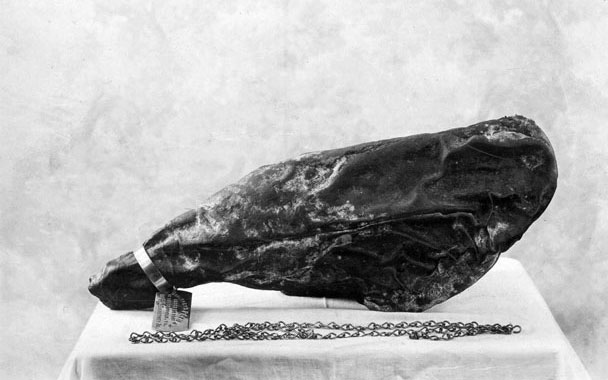When it comes to pets, we are defined by what we keep. Some of us are cat people. Others are dog people. (And ferret people, and guppy people, and gerbil people.) Lesser known are ham people, a cult whose mere existence makes potbellied pig people twitch and stammer.
Pembroke Decatur “P.D.” Gwaltney Jr. of Smithfield, Virginia, kept a pet ham.
Cured in 1902, his salted and smoked pig haunch should have been shipped to a customer that same year. Instead, it got lost in the shuffle and hung in the Gwaltney Company cure house until the 1920s, when P.D., who was evidently a student of P.T. Barnum, discovered the somewhat shriveled object of his affection.
P.D. had options, for, at that time, it was said to still be edible. He could declare his find to be vestigial American prosciutto and mete out slices to his best clients. He could, in the tradition of gifting the President with exceptional American products, ship that ham to the White House and hope the chef would see fit to serve it come Easter.
But P.D. had a grander idea. In a stunt intended to highlight the long-term storage potential of salted and smoked meat, he clamped an engraved brass collar and tag around the ham’s hock, insured it for $1,000 against fire and theft, and began traveling with his pet, showing it off at state fairs and expositions, pulling it from his suitcase so that admirers could gaze upon its goodness.
The stunt worked. Newspaper across the country reported of P.D.’s pet ham. And Ripley’s “Believe it or Not” believed the tale, writing it up at least three times, most recently in 2003, when the ham celebrated its centennial.
Now retired to a glass display case at the Isle of Wight Museum in Smithfield, his pet has, truth be told, lost a bit of its luster. The effects of salt and time, applied in the extreme, have rendered a ham that even a pet ham lover might not love.
If P.D.’s pet was singular, it might be written off to eccentricity. But I recently discovered that there are other hyper-aged American hams out there, the collective existence of which the collective existence of which suggests that pet hams sate some deep need.
Cured pork has long been a bedrock pantry item for rural Southern folk. A ham hanging in the smokehouse signified insurance against hard times. To cut into a ham in mid-winter, when food supplies dwindled and green goods were scarce, was to witness the beginning of the end—the end being, of course, starvation.
So it stands to reason that the instinct to keep rather than cut a ham has long been strong. Couple that with the knowledge that ham, like whiskey and wine, can improve with time, and you have all the rationale you need for (forgive me) salting one away.




 Pinterest
Pinterest


